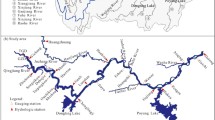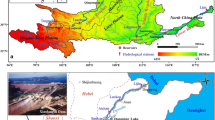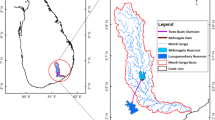Abstract
River regulation by the construction of reservoirs represents one of the greatest challenges to the natural flow regime and ecological health of riverine systems globally. The Danjiangkou (DJK) Reservoir is the largest reservoir on the Hangjiang River and commenced operations in 1967. The reservoir was upgraded in 2012 to provide water resource for the South–North water transfer project through central China. However, the effect of the reservoir operations on the downstream hydrological regime and ecological health of the Hanjiang River following the upgrade (increase in dam height and reservoir capacity) has not been examined thus far. The daily discharge series from four stations along the main stem of the Hanjiang River, including a site upstream, were examined from 1950 to 2017. The study series was divided into three periods based on the difference stages of the reservoir operation: (1) 1950–1966, (2) 1967–2012 and (3) 2013–2017. The nature of hydrological alteration, ecological flow requirement and potential ecological risk during the different periods were investigated. The results clearly indicate that the DJK reservoir has significantly modified the hydrological regime in the middle and downstream section of the Hanjiang River, with most significant modifications recorded immediately downstream of the reservoir. None of the observed ‘Range of Variability Approach’ hydrological indicators fell within the expected range at Huangjiagang following the increase in reservoir capacity. As a result, the ecological flow requirements could not be guaranteed, and the frequency and intensity of ecodeficit increased. The river ecosystem immediately downstream of the dam was observed to be at high risk of ecosystem degradation during the post-dam periods considered.



Similar content being viewed by others
Availability of data and material
All data used during the study were provided by a third party. Direct requests for these materials may be made to the provider as indicated in the Acknowledgments.
References
Ansar A, Flyvbjerg B, Budzier A, Lunn D (2014) Should we build larger dams? The actual costs of hydropower megaproject development. Energy Policy 69:43–56
Archer DR, Forsythe N, Fowler HJ, Shah SM (2010) Sustainability of water resources management in the Indus Basin under changing climatic and socio economic conditions. Hydrol Earth Syst Sci 14(8):1669–1680
Bao HF (2013) Influence analysis on biological diversity of Danjiangkou Reservoir at the middle route South–North Water Transfer Project. PhD thesis, Northeast Forestry University, Haerbin
Baumgartner G, Nakatani K, Gomes LC, Bialetzki A, Sanches PV, Makrakis MC (2008) Fish larvae from the upper Paraná River: Do abiotic factors affect larval density? Neotrop Ichthyol 6(4):551–558
Black AR, Rowan JS, Duck RW, Bragg OM, Clelland BE (2005) DHRAM: a method for classifying river flow regime alterations for the EC Water Framework Directive. Aquatic Conserv Mar Freshw Ecosyst 15(5):427–446
Casadei S, Pierleoni A, Bellezza M (2018) Sustainability of water withdrawals in the tiber river basin (Central Italy). Sustainability 10(2):485
Chen L, Singh VP, Guo S, Mishra AK, Guo J (2012) Drought analysis using copulas. J Hydrol Eng 18(7):797–808
Chen L, Yang Z, Liu H (2016a) Assessing the eutrophication risk of the Danjiangkou Reservoir based on the EFDC model. Ecol Eng 96:117–127
Chen P, Li L, Zhang H (2016b) Spatio-temporal variability in the thermal regimes of the Danjiangkou reservoir and its downstream river due to the large water diversion project system in central China. Hydrol Res 47(1):104–127
Cury P, Roy C (1989) Optimal environmental window and pelagic fish recruitment success in upwelling areas. Can J Fish Aquat Sci 46(4):670–680
Deng P, Bing J, Jia J, Wang D (2018) Pattern of spatio-temporal variability of flood season precipitation in Hanjiang river basin between 1956 and 2016. Resour Environ Yangtze Basin 27(9):2132–2141
ESCAP (2010) Economic and social commission for Asia and the Pacific (2010). United Nations, Bangkok
Gao Y, Vogel RM, Kroll CN, Poff NL, Olden JD (2009) Development of representative indicators of hydrologic alteration. J Hydrol 374(1–2):136–147
Grill G, Lehner B, Thieme M, Geenen B, Tickner D, Antonelli F, Macedo HE (2019) Mapping the world’s free-flowing rivers. Nature 569(7755):215
Gu W, Shao D, Jiang Y (2012) Risk evaluation of water shortage in source area of middle route project for South-to-North Water Transfer in China. Water Resour Manage 26(12):3479–3493
Jiang C, Xiong L, Xu CY, Guo S (2015) Bivariate frequency analysis of nonstationary low-flow series based on the time-varying copula. Hydrol Process 29(6):1521–1534
Li L, Shi ZH, Yin W, Zhu D, Ng SL, Cai CF, Lei AL (2009) A fuzzy analytic hierarchy process (FAHP) approach to eco-environmental vulnerability assessment for the Danjiangkou reservoir area, China. Ecol Model 220(23):3439–3447
Li Q, Yu M, Lu G, Cai T, Bai X, Xia Z (2011) Impacts of the Gezhouba and Three Gorges reservoirs on the sediment regime in the Yangtze River, China. J Hydrol 403(3–4):224–233
Li Q, Yu M, Zhao J, Cai T, Lu G, Xie W, Bai X (2012) Impact of the Three Gorges reservoir operation on downstream ecological water requirements. Hydrol Res 43(1–2):48–53
Li B, Li H, Zhou P (2016) Study on eco-environmental effect assessment for cascade hydropower development in Hanjiang River basin. Yangtze River 47(23):16–22
Li Y, Cui Q, Li C, Wang X, Cai Y, Cui G, Yang Z (2017) An improved multi-objective optimization model for supporting reservoir operation of China’s South-to-North Water Diversion Project. Sci Total Environ 575:970–981
Lian J, Sun X, Ma C (2016) Multi-year optimal operation strategy of Danjiangkou Reservoir after dam heightening for the middle route of south–north water transfer project. Water Sci Technol Water Supply 16:961–970
Liang K (2018) Comparative investigation on the decreased runoff between the water source and destination regions in the middle route of China’s South-to-North Water Diversion Project. Stoch Environ Res Risk Assess 32:369–384
Lu G, Liu Y, Zou X, Zou Z, Cai T (2009) Impact of the Danjiangkou Reservoir on the flow regime in the middle and lower reaches of Hanjiang River. Resour Environ Yangtze Basin 18(10):959–963
Lu G, Wang J, Li Q, Zhao J, Yu M, Cai T, Xie W (2012) mpacts of Danjiangkou reservoir on sediment regime of the Hanjiang River. Hydrol Res 43(1–2):4–72
Ministry of Water Resoureces, China (2018) http://nsbd.mwr.gov.cn/nsbdgcjszl/201809/t20180903_1046761.html
Nilsson C, Reidy CA, Dynesius M, Revenga C (2005) Fragmentation and flow regulation of the world’s large river systems. Science 308(5720):405–408
Peng T, Yang H, Guo J, Wang G, Li K (2016) Impact of the Danjiangkou reservoir operation on the downstream hydrological regime. Yangtze River 47(6):22–26
Rheinheimer DE, Liu P, Guo S (2016) Re-operating the three gorges reservoir for environmental flows: a preliminary assessment of trade-offs. River Res Appl 32(3):257–266
Richter B, Baumgartner J, Wigington R, Braun D (1997) How much water does a river need? Freshw Biol 37(1):231–249
Roy C, Cury P, Kifani S (1992) Pelagic fish recruitment success and reproductive strategy in upwelling areas: environmental compromises. S Afr J Mar Sci 12(1):135–146
Shiau JT, Wu FC (2007) Pareto‐optimal solutions for environmental flow schemes incorporating the intra‐annual and interannual variability of the natural flow regime. Water Resour Res 43(6):W06433
Song X, Zhuang Y, Wang X, Li E (2018) Combined effect of Danjiangkou reservoir and cascade reservoirs on hydrologic regime downstream. J Hydrol Eng 23(6):05018008
Suen JP, Eheart JW, Herricks EE, Chang FJ (2009) Evaluating the potential impact of reservoir operation on fish communities”. J Water Resour Plan Manag 135(6):475–483
UNEP (United Nations Environment Programme) (2007) Global environmental outlook 4: environment for development. UNEP, Nairobi
Vogel RM, Sieber J, Archfield SA, Smith MP, Apse CD, Huber Lee A (2007) Relations among storage, yield, and instream flow. Water Resour Res 43(5):W05403
Wang Y, Guo SL, Yang G, Hong XJ, Hu T (2014) Optimal early refill rules for Danjiangkou Reservoir. Water Sci Eng 7(4):403–419
Wang Y, Wang D, Wu J (2015) Assessing the impact of Danjiangkou reservoir on ecohydrological conditions in Hanjiang river, China. Ecol Eng 81:41–52
Wang Y, Wang D, Lewis QW, Wu J, Huang F (2017) A framework to assess the cumulative impacts of dams on hydrological regime: a case study of the Yangtze River. Hydrol Process 31(17):3045–3055
Wang Y, Zhang N, Wang D, Wu J, Zhang X (2018) Investigating the impacts of cascade hydropower development on the natural flow regime in the Yangtze River, China. Sci Total Environ 624:1187–1194
World Commission on Dams (2000) Dams and development: a new framework for decision-making. The Report of the World Commission on Dams. London/Sterling, Va., Earthscan
Xia J, Ma X, Zou L, Wang Y, Jing Z (2017) Quantitative analysis of the effects of climate change and human activities on runoff in the upper Hanjiang River basin. South-to-North Water Transf Water Sci Technol 15(1):1–6
Xu ZX, Takeuchi K, Ishidaira H, Zhang XW (2002) Sustainability analysis for Yellow River water resources using the system dynamics approach. Water Resour Manage 16(3):239–261
Yu M, Li Q, Lu G, Cai T, Xie W, Bai X (2013) Investigation into the Impacts of the Gezhouba and the Three Gorges Reservoirs on the Flow Regime of the Yangtze River. J Hydrol Eng 18(9):1098–1106
Zalewski M (2012) Ecohydrology-process oriented thinking for sustainability of river basins. Ecohydrol Hydrobiol 12(2):89–92
Zhang Q, Chen YD, Jiang T, Chen X, Liu Z (2011) Human-induced regulations of river channels and implications for hydrological alterations in the Pearl River Delta, China. Stoch Env Res Risk Assess 25(7):1001–1011
Zhang Q, Zhang Z, Shi P, Singh VP, Gu X (2018) Evaluation of ecological instream flow considering hydrological alterations in the Yellow River basin, China. Glob Planet Change 160:61–74
Zhao Q, Liu S, Deng L, Dong S, Yang J, Wang C (2012) The effects of dam construction and precipitation variability on hydrologic alteration in the Lancang River Basin of southwest China. Stoch Env Res Risk Assess 26(7):993–1011
Acknowledgements
Changjiang Water Resources Commission, China are thanked for providing the primary data for the research.
Funding
Financial support is gratefully acknowledged from the project (51909058, 51709074) supported by the National Natural Science Foundation of China, the Project (B200202033) supported by the Fundamental Research Funds for the Central Universities, National Key Research and Development Programs of China (2016YFA0601501).
Author information
Authors and Affiliations
Contributions
MY, PW and XL were the main contributors to this work and was responsible for developing and implementing the methods, data generation, and analysis; NG, QL, GW and JZ supervised the research.
Corresponding authors
Ethics declarations
Conflict of interest
The authors declare no competing interests.
Additional information
Publisher's Note
Springer Nature remains neutral with regard to jurisdictional claims in published maps and institutional affiliations.
Rights and permissions
About this article
Cite this article
Yu, M., Wood, P., van de Giesen, N. et al. Enhanced potential ecological risk induced by a large scale water diversion project. Stoch Environ Res Risk Assess 34, 2125–2138 (2020). https://doi.org/10.1007/s00477-020-01861-6
Published:
Issue Date:
DOI: https://doi.org/10.1007/s00477-020-01861-6




